- Home
- Stephen Hawking
Brief Answers to the Big Questions Page 6
Brief Answers to the Big Questions Read online
Page 6
According to the no-boundary proposal, asking what came before the Big Bang is meaningless—like asking what is south of the South Pole—because there is no notion of time available to refer to. The concept of time only exists within our universe.
3
IS THERE OTHER INTELLIGENT LIFE IN THE UNIVERSE?
I would like to speculate a little on the development of life in the universe, and in particular on the development of intelligent life. I shall take this to include the human race, even though much of its behaviour throughout history has been pretty stupid and not calculated to aid the survival of the species. Two questions I shall discuss are “What is the probability of life existing elsewhere in the universe?” and “How may life develop in the future?”
It is a matter of common experience that things get more disordered and chaotic with time. This observation even has its own law, the so-called second law of thermodynamics. This law says that the total amount of disorder, or entropy, in the universe always increases with time. However, the law refers only to the total amount of disorder. The order in one body can increase provided that the amount of disorder in its surroundings increases by a greater amount.
This is what happens in a living being. We can define life as an ordered system that can keep itself going against the tendency to disorder and can reproduce itself. That is, it can make similar, but independent, ordered systems. To do these things, the system must convert energy in some ordered form—like food, sunlight or electric power—into disordered energy, in the form of heat. In this way, the system can satisfy the requirement that the total amount of disorder increases while, at the same time, increasing the order in itself and its offspring. This sounds like parents living in a house which gets messier and messier each time they have a new baby.
A living being like you or me usually has two elements: a set of instructions that tell the system how to keep going and how to reproduce itself, and a mechanism to carry out the instructions. In biology, these two parts are called genes and metabolism. But it is worth emphasising that there need be nothing biological about them. For example, a computer virus is a program that will make copies of itself in the memory of a computer, and will transfer itself to other computers. Thus it fits the definition of a living system that I have given. Like a biological virus, it is a rather degenerate form, because it contains only instructions or genes, and doesn’t have any metabolism of its own. Instead, it reprograms the metabolism of the host computer, or cell. Some people have questioned whether viruses should count as life, because they are parasites, and cannot exist independently of their hosts. But then most forms of life, ourselves included, are parasites, in that they feed off and depend for their survival on other forms of life. I think computer viruses should count as life. Maybe it says something about human nature that the only form of life we have created so far is purely destructive. Talk about creating life in our own image. I shall return to electronic forms of life later on.
What we normally think of as “life” is based on chains of carbon atoms, with a few other atoms such as nitrogen or phosphorus. One can speculate that one might have life with some other chemical basis, such as silicon, but carbon seems the most favourable case, because it has the richest chemistry. That carbon atoms should exist at all, with the properties that they have, requires a fine adjustment of physical constants, such as the QCD scale, the electric charge and even the dimension of space–time. If these constants had significantly different values, either the nucleus of the carbon atom would not be stable or the electrons would collapse in on the nucleus. At first sight, it seems remarkable that the universe is so finely tuned. Maybe this is evidence that the universe was specially designed to produce the human race. However, one has to be careful about such arguments, because of the Anthropic Principle, the idea that our theories about the universe must be compatible with our own existence. This is based on the self-evident truth that if the universe had not been suitable for life we wouldn’t be asking why it is so finely adjusted. One can apply the Anthropic Principle in either its Strong or Weak versions. For the Strong Anthropic Principle, one supposes that there are many different universes, each with different values of the physical constants. In a small number, the values will allow the existence of objects like carbon atoms, which can act as the building blocks of living systems. Since we must live in one of these universes, we should not be surprised that the physical constants are finely tuned. If they weren’t, we wouldn’t be here. The Strong form of the Anthropic Principle is thus not very satisfactory, because what operational meaning can one give to the existence of all those other universes? And if they are separate from our own universe, how can what happens in them affect our universe? Instead, I shall adopt what is known as the Weak Anthropic Principle. That is, I shall take the values of the physical constants as given. But I shall see what conclusions can be drawn from the fact that life exists on this planet at this stage in the history of the universe.
There was no carbon when the universe began in the Big Bang, about 13.8 billion years ago. It was so hot that all the matter would have been in the form of particles called protons and neutrons. There would initially have been equal numbers of protons and neutrons. However, as the universe expanded, it cooled. About a minute after the Big Bang, the temperature would have fallen to about a billion degrees, about a hundred times the temperature in the Sun. At this temperature, neutrons start to decay into more protons.
If this had been all that had happened, all the matter in the universe would have ended up as the simplest element, hydrogen, whose nucleus consists of a single proton. However, some of the neutrons collided with protons and stuck together to form the next simplest element, helium, whose nucleus consists of two protons and two neutrons. But no heavier elements, like carbon or oxygen, would have been formed in the early universe. It is difficult to imagine that one could build a living system out of just hydrogen and helium—and anyway the early universe was still far too hot for atoms to combine into molecules.
The universe continued to expand and cool. But some regions had slightly higher densities than others and the gravitational attraction of the extra matter in those regions slowed down their expansion, and eventually stopped it. Instead, they collapsed to form galaxies and stars, starting from about two billion years after the Big Bang. Some of the early stars would have been more massive than our Sun; they would have been hotter than the Sun and would have burned the original hydrogen and helium into heavier elements, such as carbon, oxygen and iron. This could have taken only a few hundred million years. After that, some of the stars exploded as supernovae and scattered the heavy elements back into space, to form the raw material for later generations of stars.
Other stars are too far away for us to be able to see directly if they have planets going round them. However, there are two techniques that have enabled us to discover planets around other stars. The first is to look at the star and see if the amount of light coming from it is constant. If a planet moves in front of the star, the light from the star will be slightly obscured. The star will dim a little bit. If this happens regularly, it is because a planet’s orbit is taking it in front of the star repeatedly. A second method is to measure the position of the star accurately. If a planet is orbiting the star, it will induce a small wobble in the position of the star. This can be observed and again, if it is a regular wobble, then one deduces that it is due to a planet in orbit around the star. These methods were first applied about twenty years ago and by now a few thousand planets have been discovered orbiting distant stars. It is estimated that one star in five has an Earth-like planet orbiting it at a distance from the star to be compatible with life as we know it. Our own solar system was formed about four and a half billion years ago, or a little more than nine billion years after the Big Bang, from gas contaminated with the remains of earlier stars. The Earth was formed largely out of the heavier elements, including carbon and oxygen. Somehow, some of these atoms came to be arranged
in the form of molecules of DNA. This has the famous double-helix form, discovered in the 1950s by Francis Crick and James Watson in a hut on the New Museum site in Cambridge. Linking the two chains in the helix are pairs of nitrogenous bases. There are four types of nitrogenous bases—adenine, cytosine, guanine and thymine. An adenine on one chain is always matched with a thymine on the other chain, and a guanine with a cytosine. Thus the sequence of nitrogenous bases on one chain defines a unique, complementary sequence on the other chain. The two chains can then separate and each acts as a template to build further chains. Thus DNA molecules can reproduce the genetic information coded in their sequences of nitrogenous bases. Sections of the sequence can also be used to make proteins and other chemicals, which can carry out the instructions, coded in the sequence, and assemble the raw material for DNA to reproduce itself.
As I said earlier, we do not know how DNA molecules first appeared. As the chances against a DNA molecule arising by random fluctuations are very small, some people have suggested that life came to Earth from elsewhere—for instance, brought here on rocks breaking off from Mars while the planets were still unstable—and that there are seeds of life floating round in the galaxy. However, it seems unlikely that DNA could survive for long in the radiation in space.
If the appearance of life on a given planet was very unlikely, one might have expected it to take a long time. More precisely, one might have expected life to appear as late as possible while still allowing time for the subsequent evolution to intelligent beings, like us, before the Sun swells up and engulfs the Earth. The time window in which this could occur is the lifetime of the Sun—about ten billion years. In that time, an intelligent form of life could conceivably master space travel and be able to escape to another star. But if no escape is possible, life on Earth would be doomed.
There is fossil evidence that there was some form of life on Earth about three and a half billion years ago. This may have been only 500 million years after the Earth became stable and cool enough for life to develop. But life could have taken seven billion years to develop in the universe and still have left time to evolve to beings like us, who could ask about the origin of life. If the probability of life developing on a given planet is very small, why did it happen on Earth in about one-fourteenth of the time available?
The early appearance of life on Earth suggests that there is a good chance of the spontaneous generation of life in suitable conditions. Maybe there was some simpler form of organisation which built up DNA. Once DNA appeared, it would have been so successful that it might have completely replaced the earlier forms. We don’t know what these earlier forms would have been, but one possibility is RNA.
RNA is like DNA, but rather simpler, and without the double-helix structure. Short lengths of RNA could reproduce themselves like DNA, and might eventually build up to DNA. We cannot make these nucleic acids in the laboratory from non-living material. But given 500 million years, and oceans covering most of the Earth, there might be a reasonable probability of RNA being made by chance.
As DNA reproduced itself, there would have been random errors, many of which would have been harmful and would have died out. Some would have been neutral—they would not have affected the function of the gene. And a few errors would have been favourable to the survival of the species—these would have been chosen by Darwinian natural selection.
The process of biological evolution was very slow at first. It took about two and a half billion years before the earliest cells evolved into multi-cellular organisms. But it took less than another billion years for some of these to evolve into fish, and for some of the fish, in turn, to evolve into mammals. Then evolution seems to have speeded up even more. It took only about a hundred million years to develop from the early mammals to us. The reason is that the early mammals already contained their versions of the essential organs we have. All that was required to evolve from early mammals to humans was a bit of fine-tuning.
But with the human race evolution reached a critical stage, comparable in importance with the development of DNA. This was the development of language, and particularly written language. It meant that information could be passed on from generation to generation, other than genetically through DNA. There has been some detectable change in human DNA, brought about by biological evolution, in the 10,000 years of recorded history, but the amount of knowledge handed on from generation to generation has grown enormously. I have written books to tell you something of what I have learned about the universe in my long career as a scientist, and in doing so I am transferring knowledge from my brain to the page so you can read it.
The DNA in a human egg or sperm contains about three billion base pairs of nitrogenous bases. However, much of the information coded in this sequence seems to be redundant or is inactive. So the total amount of useful information in our genes is probably something like a hundred million bits. One bit of information is the answer to a yes/no question. By contrast, a paperback novel might contain two million bits of information. Therefore, a human is equivalent to about fifty Harry Potter books, and a major national library can contain about five million books—or about ten trillion bits. The amount of information handed down in books or via the internet is 100,000 times as much as there is in DNA.
Even more important is the fact that the information in books can be changed, and updated, much more rapidly. It has taken us several million years to evolve from less advanced, earlier apes. During that time, the useful information in our DNA has probably changed by only a few million bits, so the rate of biological evolution in humans is about a bit a year. By contrast, there are about 50,000 new books published in the English language each year, containing of the order of a hundred billion bits of information. Of course, the great majority of this information is garbage and no use to any form of life. But, even so, the rate at which useful information can be added is millions, if not billions, higher than with DNA.
This means that we have entered a new phase of evolution. At first, evolution proceeded by natural selection—from random mutations. This Darwinian phase lasted about three and a half billion years and produced us, beings who developed language to exchange information. But in the last 10,000 years or so we have been in what might be called an external transmission phase. In this, the internal record of information, handed down to succeeding generations in DNA, has changed somewhat. But the external record—in books and other long-lasting forms of storage—has grown enormously.
Some people would use the term “evolution” only for the internally transmitted genetic material and would object to it being applied to information handed down externally. But I think that is too narrow a view. We are more than just our genes. We may be no stronger or inherently more intelligent than our caveman ancestors. But what distinguishes us from them is the knowledge that we have accumulated over the last 10,000 years, and particularly over the last 300. I think it is legitimate to take a broader view and include externally transmitted information, as well as DNA, in the evolution of the human race.
The timescale for evolution in the external transmission period is the timescale for accumulation of information. This used to be hundreds, or even thousands, of years. But now this timescale has shrunk to about fifty years or less. On the other hand, the brains with which we process this information have evolved only on the Darwinian timescale, of hundreds of thousands of years. This is beginning to cause problems. In the eighteenth century, there was said to be a man who had read every book written. But nowadays, if you read one book a day, it would take you many tens of thousands of years to read through the books in a national library. By which time, many more books would have been written.
This has meant that no one person can be the master of more than a small corner of human knowledge. People have to specialise, in narrower and narrower fields. This is likely to be a major limitation in the future. We certainly cannot continue, for long, with the exponential rate of growth of knowledge that we have had in the l
ast 300 years. An even greater limitation and danger for future generations is that we still have the instincts, and in particular the aggressive impulses, that we had in caveman days. Aggression, in the form of subjugating or killing other men and taking their women and food, has had definite survival advantage up to the present time. But now it could destroy the entire human race and much of the rest of life on Earth. A nuclear war is still the most immediate danger, but there are others, such as the release of a genetically engineered virus. Or the greenhouse effect becoming unstable.
There is no time to wait for Darwinian evolution to make us more intelligent and better natured. But we are now entering a new phase of what might be called self-designed evolution, in which we will be able to change and improve our DNA. We have now mapped DNA, which means we have read “the book of life,” so we can start writing in corrections. At first, these changes will be confined to the repair of genetic defects—like cystic fibrosis and muscular dystrophy, which are controlled by single genes and so are fairly easy to identify and correct. Other qualities, such as intelligence, are probably controlled by a large number of genes, and it will be much more difficult to find them and work out the relations between them. Nevertheless, I am sure that during this century people will discover how to modify both intelligence and instincts like aggression.
Laws will probably be passed against genetic engineering with humans. But some people won’t be able to resist the temptation to improve human characteristics, such as size of memory, resistance to disease and length of life. Once such superhumans appear, there are going to be major political problems with the unimproved humans, who won’t be able to compete. Presumably, they will die out, or become unimportant. Instead, there will be a race of self-designing beings, who are improving themselves at an ever-increasing rate.

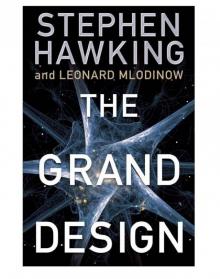 The Grand Design
The Grand Design A Brief History of Time
A Brief History of Time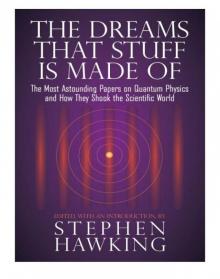 The Dreams That Stuff is Made of
The Dreams That Stuff is Made of My Brief History
My Brief History A Briefer History of Time
A Briefer History of Time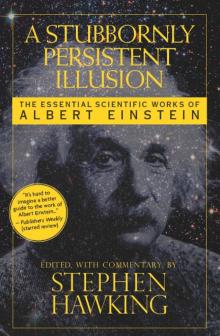 A Stubbornly Persistent Illusion
A Stubbornly Persistent Illusion George and the Blue Moon
George and the Blue Moon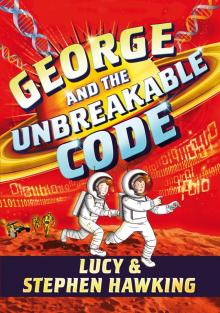 George and the Unbreakable Code
George and the Unbreakable Code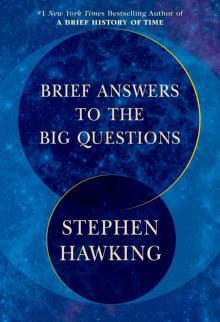 Brief Answers to the Big Questions
Brief Answers to the Big Questions George's Secret Key to the Universe
George's Secret Key to the Universe